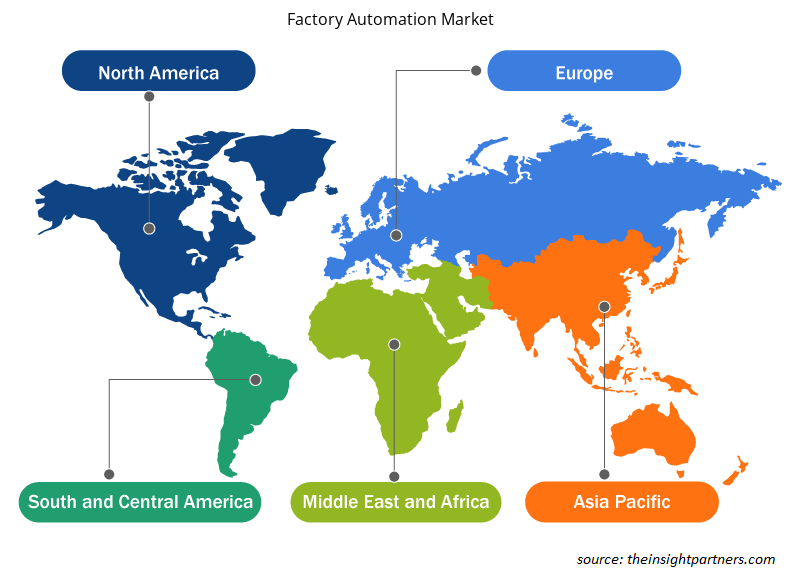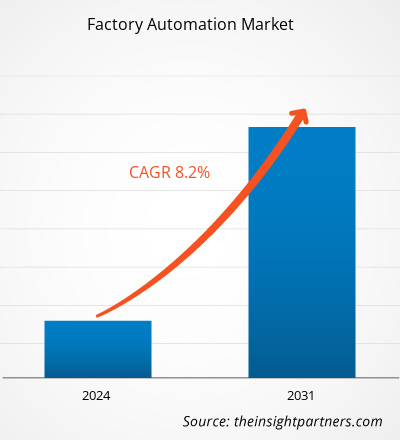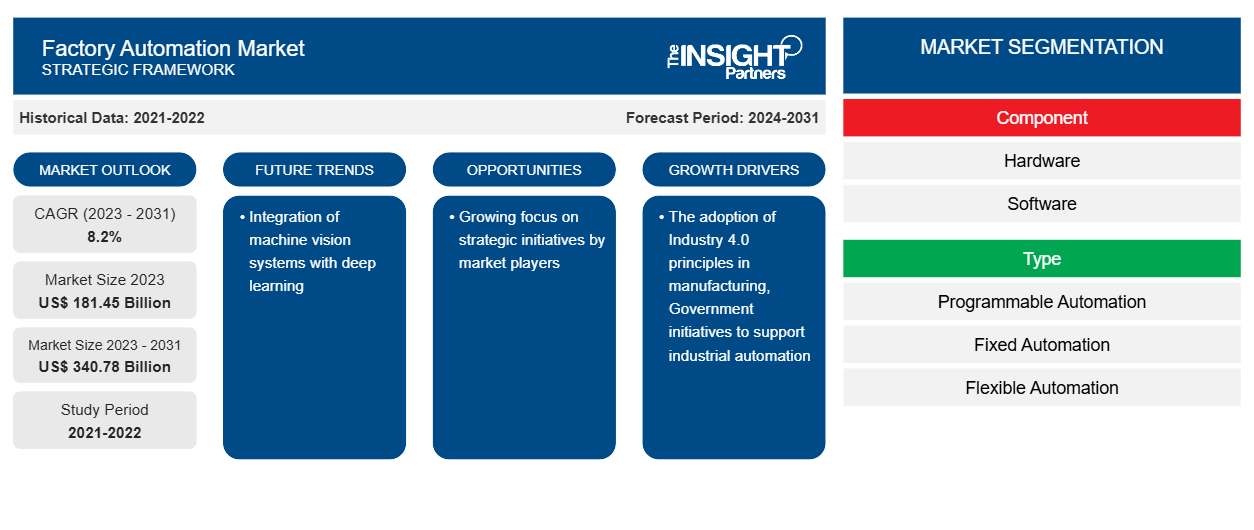工厂自动化市场预计将从 2023 年的 1814.5 亿美元增长到 2031 年的 3407.8 亿美元;预计从 2023 年到 2031 年的复合年增长率为 8.2%。机器视觉系统与深度学习的结合预计将成为市场的一个主要趋势。
工厂自动化市场分析
过去十年,制造业发展迅速。全球化正在扩大市场,吸引大量新参与者。主要公司可以通过产品差异化、成本领先、目标营销和出色的售后服务在工厂自动化市场中建立竞争优势。自动化是生产过程的关键因素。此外,先进的自动化解决方案可以实现始终如一的高质量、高产量和低生产成本。因此,工厂自动化市场预计将在预测期内增长。
工厂自动化市场行业概况
工厂自动化是将自动化集成到制造过程的所有阶段。制造中的自动化经常结合气动系统、液压系统和机械臂等技术来生产更复杂的系统。在竞争激烈的环境中,工厂自动化可以帮助提高产量和效率,同时降低成本。工厂自动化提供了一种引人注目的方法,可以在快速变化的现代工厂环境中提高效率、质量、可持续性、安全性和保障性。
定制此报告以满足您的需求
您可以免费定制任何报告,包括本报告的部分内容、国家级分析、Excel 数据包,以及为初创企业和大学提供优惠和折扣
- 获取此报告的关键市场趋势。这个免费样品将包括数据分析,从市场趋势到估计和预测。
工厂自动化市场驱动因素和机遇
制造业采用工业4.0原则以促进市场增长。
第四次工业革命(工业 4.0)的革命性力量正在改变全球生产。工业 4.0 的部分定义是智能系统、人工智能 (AI)、大数据和先进的 IT 架构,代表了整个制造业发展的下一步,许多企业正在采用这些技术。工业 4.0 流程、技术和系统的好处包括提高生产力和效率、提高敏捷性和灵活性以及提高盈利能力。因此,预计在预测期内,众多行业采用工业 4.0 进行自动化将推动工厂自动化市场的增长。
市场参与者日益关注战略举措
主要市场参与者越来越关注合并、收购和协作等战略活动,这预计将推动工厂自动化市场的增长。例如,2021 年 7 月,从事工业自动化和数字化转型的罗克韦尔自动化公司宣布收购领先的云原生智能制造平台 Plex Systems。此外,2021 年 9 月,罗克韦尔自动化公司宣布与基于云的产品数字化和可追溯性平台 Kezzler 建立合作伙伴关系,以帮助制造商使用专注于产品可追溯性的基于云的供应链解决方案来捕捉其产品从原材料来源到销售点或更远地方的旅程。
工厂自动化市场报告细分分析
有助于得出工厂自动化市场分析的关键部分是组件、类型、技术和行业垂直。
- 根据组件,市场分为硬件和软件
- 根据类型,市场分为可编程自动化、固定自动化和灵活自动化)。
- 根据技术,市场分为可编程逻辑控制器 (PLC)、分布式控制系统 (DCS)、监控和数据采集系统 (SCADA)、人机界面 (HMI) 等。
- 根据行业垂直划分,市场分为汽车、食品和饮料、石油和天然气、制造业、采矿业和其他。
工厂自动化市场份额按地区分析
根据地区,市场分为北美、欧洲、亚太、中东和非洲、南美和中美。
预计在预测期内,北美将占据工厂自动化市场的主导份额。这种增长可能归因于早期的技术采用和对研发活动的高度重视。此外,协作机器人的日益普及和政府对各行业数字化转型的举措预计将在预测期内推动工厂自动化市场的发展。
工厂自动化市场区域洞察
Insight Partners 的分析师已详细解释了预测期内影响工厂自动化市场的区域趋势和因素。本节还讨论了北美、欧洲、亚太地区、中东和非洲以及南美和中美洲的工厂自动化市场细分和地理位置。

- 获取工厂自动化市场的区域特定数据
工厂自动化市场报告范围
| 报告属性 | 细节 |
|---|---|
| 2023 年的市场规模 | 1814.5亿美元 |
| 2031 年市场规模 | 3407.8亿美元 |
| 全球复合年增长率(2023 - 2031) | 8.2% |
| 史料 | 2021-2022 |
| 预测期 | 2024-2031 |
| 涵盖的领域 | 按组件
|
| 覆盖地区和国家 | 北美
|
| 市场领导者和主要公司简介 |
|
工厂自动化市场参与者密度:了解其对业务动态的影响
工厂自动化市场正在快速增长,这得益于最终用户需求的不断增长,而这些需求又源于消费者偏好的不断变化、技术进步以及对产品优势的认识不断提高等因素。随着需求的增加,企业正在扩大其产品范围,进行创新以满足消费者的需求,并利用新兴趋势,从而进一步推动市场增长。
市场参与者密度是指在特定市场或行业内运营的企业或公司的分布情况。它表明在给定市场空间中,相对于其规模或总市场价值,有多少竞争对手(市场参与者)存在。
在工厂自动化市场运营的主要公司有:
- ABB有限公司
- 艾默生电气公司
- 发那科公司
- 通用电气公司
- 三菱电机公司
- 霍尼韦尔国际公司
免责声明:上面列出的公司没有按照任何特定顺序排列。

- 了解工厂自动化市场顶级关键参与者概况
工厂自动化市场新闻和最新发展
工厂自动化市场通过收集一手和二手研究后的定性和定量数据进行评估,其中包括重要的公司出版物、协会数据和数据库。工厂自动化的一些发展如下所列:
- 三菱电机公司宣布,将向其子公司三菱电机印度私人有限公司投资约 22 亿印度卢比(约合 31 亿日元),在印度建立新工厂。新工厂预计将于 2023 年 12 月开始运营,将生产逆变器和其他工厂自动化 (FA) 控制系统产品,扩大公司的能力以满足印度日益增长的需求。(来源:三菱电机公司,新闻稿,2022 年 6 月)
工厂自动化市场报告范围和交付成果
工厂自动化市场预测是根据各种二手和一手研究结果估算的,例如主要公司出版物、协会数据和数据库。市场报告“工厂自动化市场规模和预测(2021-2031 年)”对市场进行了详细分析,涵盖以下领域:
- 工厂自动化市场规模及全球、区域和国家层面所有关键细分市场的预测
- 工厂自动化市场趋势以及市场动态,如驱动因素、限制因素和关键机遇
- 详细的 PEST/波特五力分析和 SWOT 分析
- 工厂自动化市场分析涵盖主要市场趋势、全球和区域框架、主要参与者、法规和最新市场发展
- 行业格局和竞争分析,涵盖市场集中度、热图分析、知名参与者以及工厂自动化市场的最新发展
- 详细的公司简介。
- 历史分析(2 年)、基准年、预测(7 年)及复合年增长率
- PEST和SWOT分析
- 市场规模、价值/数量 - 全球、区域、国家
- 行业和竞争格局
- Excel 数据集
近期报告
客户评价
购买理由
- 明智的决策
- 了解市场动态
- 竞争分析
- 客户洞察
- 市场预测
- 风险规避
- 战略规划
- 投资论证
- 识别新兴市场
- 优化营销策略
- 提升运营效率
- 顺应监管趋势





















 获取免费样品 - 工厂自动化市场
获取免费样品 - 工厂自动化市场